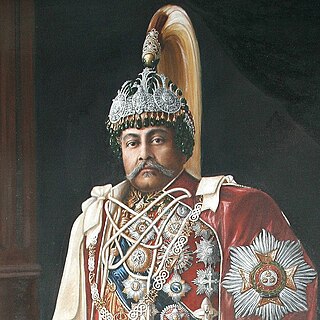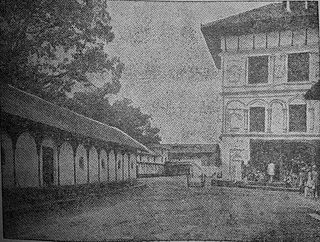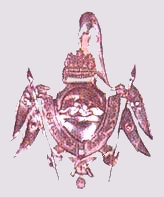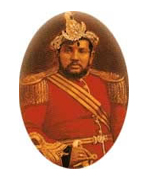 W
WThe revolution of 1951 in Nepal, also referred to as Sat Salko Kranti, was a political movement against the direct rule by the Rana dynasty of Nepal. It marks the beginning of the political awakening and democratic movements in Nepal, and resulted in immediate abolition of the institutionalized hereditary Prime Minister system in Nepal.
 W
WMaharaja Jung Bahadur Kunwar Ranaji, was a Khas Rajput (Chhetri) ruler of Nepal and initiator of the Rana Regime in Nepal. Jung Bahadur took control of the government after killing a suspected usurper, Gagan Singh, who was accused of plotting to become prime minister with the junior queen in 1846 and put her son on the throne. He was born as Bir Narsingh Kunwar but he became known by the name Jang Bahadur, given to him by his maternal uncle Mathabar Singh Thapa who used to call him Jangay as commemoration of his boldness and courage.
 W
WThe Chandra Canal is an irrigation canal project established in the northeastern Saptari district of Nepal by Chandra Shumsher Jang Bahadur Rana, one of the Prime Ministers during the Rana era (1846–1951) of Nepal, was the first canal in the country. It is originated from the Triyuga river at Fattepur. The canal was constructed by the first engineer of Nepal, Dilli Jung Thapa.
 W
WThe Jayatu Sanskritam movement begin in 1947 AD(BS 2004), started by students of the Tin Dhara Pakshala Sanskrit School in Nepal. They demanded democracy, basic welfare, and the inclusion of modern subjects in their curriculum. It was the first student uprising in Nepal's history, and led to the Revolution of 1951 and the fall of the Rana dynasty.
 W
WField Marshal Shree Shree Shree Maharaja Sir Juddha Shumsher Jang Bahadur Rana was the Prime Minister of Nepal from 1 September 1932 to 29 November 1945 as the head of the Rana Dynasty.
 W
WThe Kot massacre took place on 14 September 1846 when then Kaji Jang Bahadur Kunwar and his brothers killed about 30-40 civil, military officers and palace guards of the Nepalese palace court including the Prime Minister of Nepal and a relative of the King, Chautariya Fateh Jung Shah and other senior-most ministers and army generals at the palace armory (Kot) of Hanuman Dhoka in Kathmandu. The Kot meeting was called upon by Queen Rajya Laxmi Devi after the same night murder of her confidante Kaji Gagan Singh Bhandari while performing worship at his prayer room. The Kot meeting turned ugly and eventually, Jang brothers and their supporters led an open court full-fledged assault on all his rival participants in the meeting. This massacre led to the loss of power of political clans such as Chautariyas, Pandes, Thapas, and Basnyats and that of King Rajendra Bikram Shah and Queen Rajya Laxmi Devi and ultimately the establishment of the Rana autocracy in Nepal.
 W
WHis Excellency Commanding General Shree Shree Shree Maharaja Sir Ranaudip Singh Bahadur Kunwar Ranaji, KCSI, commonly known as Ranodip Singh Kunwar was the second Prime Minister of Nepal from the Rana dynasty.
 W
WThe Nepal Praja Parishad was the first attempt to form an organization to lead the revolution against the Rana dynasty in Nepal. Led by Tanka Prasad Acharya, the group was founded in 1936, and is seen as the first political party in Nepal. The organisation collapsed after their plot to assassinate multiple members of the Rana regime was discovered, and some of its key members were executed.
 W
WRana dynasty is a Chhetri dynasty that ruled the Kingdom of Nepal from 1846 until 1951, reducing the Shah monarch to a figurehead and making Prime Minister and other government positions held by the Ranas hereditary. They claimed Kshatriya status themselves. Rana dynasty is historically known for the iron-fisted rule. This changed after the Revolution of 1951 with the promulgation of a new constitution, when power shifted back to the monarchy of King Tribhuvan.
 W
WSir Baber Shumsher Jang Bahadur Rana, GCVO, GBE, KCSI, KCIE was a member of the Rana dynasty who served as the Minister of Defence of Nepal in 1951. A prominent member of the Rana oligarchy, he fought valiantly in the First World War. He was the second son of Maharaja Sir Chandra Shamsher Jang Bahadur Rana and Bada Maharani Chandra Loka Bhakta Lakshmi Devi. He was the younger brother of Maharaja Sir Mohan Shamsher Jang Bahadur Rana and older brother of Field Marshal Sir Kaiser Shamsher Jang Bahadur Rana.
 W
WCommanding General Shree Shree Shree Maharaja Sir Bir Shumsher Jung Bahadur Rana was the 11th Prime Minister of Nepal. He is remembered as a statesman who made important reforms and infrastructure improvements. Bir Shamsher Jung Bahadur Rana was known as Kailay in his childhood; this name was given by Jung Bahadur. His mother was daughter of Pahalman Singh Basnyat and sister of lalitman Singh Basnyat .His mother died as soon as he was born and he was taken care of by Putali Maharani, wife of Jung Bahadur. He spent his childhood at Thapathali Durbar.
 W
WField-Marshal Maharaja Sri Teen Chandra Shumsher Junga Bahadur Rana was the Prime Minister of Nepal from the Rana dynasty. He served in this capacity from 27 June 1901 to his death in 1929, after he successfully deposed his liberal and reformist brother Dev Shamsher. Although generally perceived as despotic and conservative, he is credited with several reforms including the abolition of slavery and the Nepal-Britain Treaty of 1923, which recognized Nepal as an independent nation and an ally of Britain.
 W
WSri Maharaja, Dev Shamsher Jung Bahadur Rana was the Prime Minister of Nepal for 114 days in 1901. He was also the Maharaja of Lamjung and Kaski.
 W
WDhir Shamsher Kunwar after 1848 known as Dhir Shamsher Kunwar Ranaji or Dhir Shamsher Jang Kunwar Ranaji or shortly Dhir Shamsher Rana posthumously known as Dhir Shamsher Jang Bahadur Rana was a Nepalese politician, army general and minister of state. He served as the Commander-In-Chief of the Nepalese Army from 1879 to 1884 A.D. He was born in Kunwar family as the youngest son of Kaji Bal Narsingh Kunwar and Ganesh Kumari Thapa, daughter of Kaji Nain Singh Thapa of Thapa dynasty. Dhir Shamsher was the youngest brother of Jang Bahadur Kunwar Ranaji, who rose to premiership of Nepal after the murders of influential persons - Mathabarsingh Thapa and Gagan Singh Bhandari and the incidence of Kot Massacre. Dhir was personally involved in the massacre protecting his nearly slaughtered brother Krishna Bahadur Kunwar Rana. Dhir became military Colonel after the incident. He was in the entourage of Jung Bahadur's visit of Europe in the early 1850s.
 W
WGehendra Shumsher was a Nepali innovator, firearm designer, and general in the then Nepali Army. He was the eldest son of Bir Shumsher, the third prime minister of the Rana dynasty. He is generally regarded as the first scientist of Nepal.
 W
WField Marshal Sir Kaiser Shumsher Jang Bahadur Rana, GBE was a field marshal in the Royal Nepalese Army. He was the third son of Maharaja Sir Chandra Shamsher Jang Bahadur Rana, GCB, GCSI, GCMG, GCVO the fifth Prime Minister of Nepal of the Rana dynasty and Bada Maharani Chandra Loka Bhaktha Rajya Lakshmi. He was the younger brother of Shree Tin Maharaja Sir Mohan Shamsher Jang Bahadur Rana and Sir Baber Shamsher Jang Bahadur Rana.
 W
WField-Marshal Shree Shree Shree Maharaja Sir Mohan Shumsher Jung Bahadur Rana, GCB, GCIE, GBE was the prime minister and foreign minister of Nepal from 30 April 1948 until 12 November 1951.
 W
WField Marshal His Highness Shree Shree Shree Maharaja Sir Padma Shumsher Jung Bahadur Rana was the hereditary prime minister of Nepal from 29 November 1945 to 30 April 1948 as the head of the Rana dynasty.
 W
WSubarna Shamsher Rana was a leading figure in the movement to overthrow the ruling Rana oligarchy and to establish democracy in Nepal. He was one of the three leaders of the Nepali Congress in the late 1940s, opposing his relatives, the Rana family, who held power in Nepal at the time. He is one of the most revered leaders of Nepali Congress. He died in Calcutta on 9 November 1977. Sashi Sumsher and Yog Prasad Upadhyay brought his ashes back to Nepal.
 W
WColonel Gajraj Singh Thapa was the first person to establish tea plantation estates in Nepal. Around 1873, Thapa, son-in-law of Prime Minister Jung Bahadur Rana, was on a tour of Darjeeling. He was impressed by the sight of the young tea plants and the taste of the drink he was offered everywhere he went. Upon his return to Nepal, he set up two plantations – the Ilam and Soktim tea estates, 103 acres (42 ha) each – and so began Nepal's tea industry. Colonel Thapa was then the Governor General of the eastern region of Nepal. Translation of various signposts placed in Ilam, reads that the very first tea saplings planted by Thapa was received as a gift from the Government of China, it was gifted to his father-in-law prime minister Jung Bahadur Rana. According to the signpost the genus of tea planted in the estate were Camellia sinensis/Camellia Assamica/Camellia assamica sub sp Lasiocalyx or cambodensis.